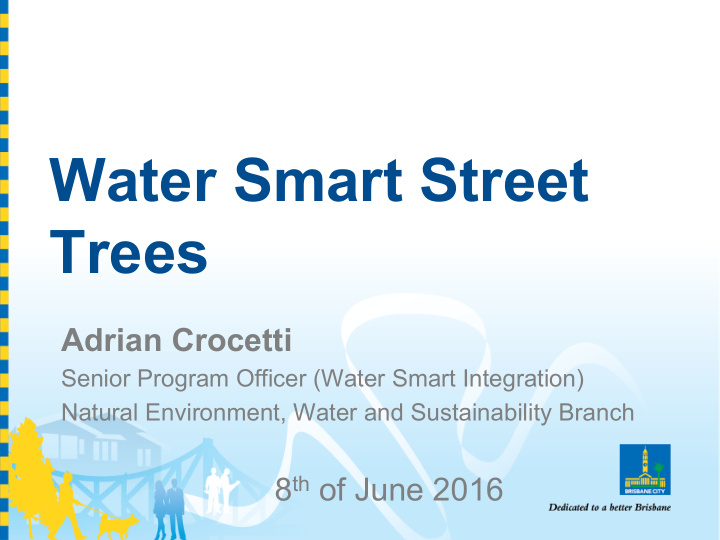



Water Smart Street Trees Adrian Crocetti Senior Program Officer (Water Smart Integration) Natural Environment, Water and Sustainability Branch 8 th of June 2016
Introduction Topics to be covered: 1. Brisbane’s stormwater story 2. Water smart street trees and their benefits 3. Drivers and processes to implementation 4. Working together 5. Factors of success
Water Smart Strategy Four Principles of the WaterSmart Strategy • Well-designed subtropical city – Designing and reorienting our city with water in mind. • A healthy river and bay – Improving the health and resilience of our local waterways, the Brisbane River and Moreton Bay. • Sustainable water use – Sustainably managing our water, ensuring we have what we need now and for future generations. • A water smart community – A community that is connected to water, participates in decision making and takes action to manage water sustainably.
The Strategy – Purpose and New Key Directions Watercycle Watersmart Waterway Drained Sewered Water supply Natural city city city city city city ? Beyond the water cycle… • Adap%ve ¡mul%func%onal ¡infrastructure ¡ • Urban ¡design ¡reinforcing ¡water ¡sensi%ve ¡behaviours ¡ • Intergenera%onal ¡equity ¡ • Resilient ¡ • Natural ¡Assets ¡ • Social…
The Strategy – Purpose and New Key Directions A Water Smart city = A Liveable, Sustainable and Resilient C ity Has Water in the Landscape Vegetation, cooling, treatment Creates Open and Green Spaces for community use - overland flow paths, waterways and flood plains Drives Economic Growth smart use of space and resources, innovation, investment Meets Challenges Growth, climate change, existing issues, collaborative governance, water pervasiveness Fosters Biodiversity and Healthy Waterways Underpinned by Diverse Water Supplies Availability, security, affordability
Water Smart Street Trees (Before) Liveable, Sustainable and Resilient
Water Smart Street Trees (After)
System Schematic
Drivers • Resilience • Heat Island Effect • Reduced Maintenance • Sustainable Practices
Benefits WSUD Street Trees provide multiple benefits including: Direct Benefits: • Providing additional water and nutrients for street trees reduces maintenance • Treating polluted stormwater • Improves tree growth, health and survival rates Indirect Benefits: • Aesthetic improvement • Cooling (reduced heat island effect)
Benefits • Council’s commitment to WaterSmart initiatives and strategies to respond to future development • Demonstrating Councils compliance with new legal requirements • Establishing effective mainstreaming systems and processes • Integrating works and developing partnerships within Council • Achieving multiple outcomes • Reduced costs
Process for implementation Situation ¡ Why self-watering street trees are suitable ¡ In place of a standard street tree ¡ Standard street trees require little modification to turn them into self-watering street trees. They appear visually identical and can be implemented many places that standard street trees can. ¡ To reduce stormwater volumes ¡ Self-watering street trees infiltrate stormwater into the ground. This helps to reduce the amount of erosive stormwater that reaches creeks, and helps to mimic natural hydrology. ¡ For managing nutrients, metals and Self-watering street trees direct pollutants in stormwater into the sub-soil beneath the trees heavy carbons in stormwater ¡ where they are retained. ¡ On flat to moderately sloping terrain ¡ Self-watering street trees can be implemented on both any grade where the inlet can be configured to direct water from the kerb and beneath the tree. This typically means that they can be implemented on flat to moderately sloping (10%) sites. ¡
Process for implementation Situation ¡ Why self-watering street trees are not suitable ¡ Exceptionally high sediment loads Self-watering street trees rely on the permeability of the water distribution pipe in order to (likely to block inlet) ¡ function. High sediment loads risk blocking the pipe. ¡ Grades steeper than 10% ¡ Self-watering street trees need to be implemented on grades sufficiently shallow to allow water to be directed into the inlet. To date, self-watering street trees have been implemented on grades less than and equal to 10% ¡ Toxic runoff ¡ Self-watering street trees require a healthy tree in order to function. They should not be implemented on sites with sufficiently poor quality water such that the health of the tree is likely to be impaired. ¡ Continuous inflows ¡ Continuous inflows into self-watering street trees risk saturating the sub-soil and damaging the health of the tree. ¡ Sodic soils ¡ Sodic soils are prone to erosion. Infiltrating water should be avoided where sodic soils are present. ¡ Adjacent to roads with known Infiltrating water adjacent to roads with unstable foundations is unwise in case the water unstable foundations ¡ further destabilises the foundation of the road. ¡
Water Smart Street Tree Design and it’s Evolution Street tree without underdrainage
Success Factors to Date • Mainstreaming across Council • Experimental developments • Continuous Improvement • Decreasing installation costs • Collaboration
Recommend
More recommend